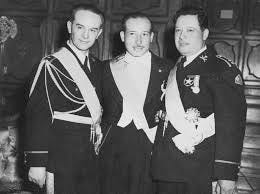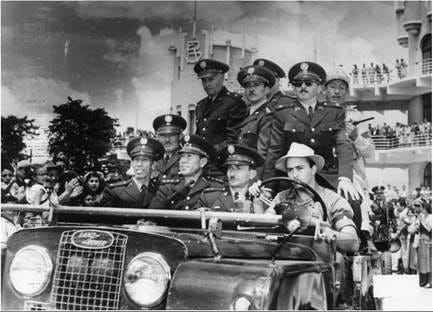United Fruit Company's Coup
How a banana company overthrew the first democratic government of Guatemala
In 1944, a powerful democratic movement arose in Guatemala. For over a decade, the country had been controlled by authoritarian dictator General Jorge Ubico. The economy of Guatemala relied extensively on two exports: coffee and bananas. General Ubico employed a police state military and harsh labor regulations to seize land from local farmers and offer it to an American corporation, the United Fruit Company (UFCO). The government made millions of dollars exporting bananas, but a vast population of Guatemalans no longer owned property. This was the basis for the democratic movement, led by political leader Juan José Arévalo and military leader Jacobo Árbenz. The movement was, ironically, inspired by America’s democracy, specifically FDR’s liberal policies in the New Deal.
In October 1944, Arbenz led what would later be known as the “October Revolution.” After overthrowing General Ubico’s regime, the first free election in decades was held in Guatemala. Juan Arevalo won the presidency in a landslide. Arevalo proceeded to implement democratic and social reform policies. Freedom of the press, promoting education, and disbanding the police state. Arevalo’s presidential term ended in 1951. He was succeeded by Arbenz, who won the 1951 election in a landslide, running on the same liberal platform as his predecessor. Except, Arbenz was prepared to truly liberalize his country from the firm grasp UFCO held on it.
Back in America, in the wake of World War II, the National Security Act of 1947 was passed and formally authorized the first peacetime U.S. intelligence agency – the CIA. For the first time in U.S. history, the government was collecting intel on foreign countries in times of peace. Although the CIA was just a baby, the agency quickly found its niche, doing the dirty work of fighting communism around the world on behalf of the U.S. government. The CIA organized Ukrainians to fight against the Soviet Union, overthrew the “communist” Iranian government in 1953, and sponsored anti-communism in many other countries in the late 1940s and early 1950s. Guatemala was on the CIA’s radar as well. Arbenz had won his election, in part, by accepting the Communists faction of Guatemalans. Although there were only 4,000 registered Communists in the country at the time, the CIA took note of this potentially dangerous allegiance.
In the summer of 1952, Arbenz signed Decree 900. Decree 900 was created to redistribute farmland, as a vast majority of farmers in 1952 were still landless. However, UFCO owned nearly half the farmland in Guatemala. Under dictator General Ubico, UFCO had also earned an exemption from paying property taxes and import duties. Arbenz was directly attacking UFCO with his new Guatemala first agenda. Arbenz acquired much of the land owned by UFCO. UFCO was compensated for the land, but the exact number was based on the 1952 tax assessments. Since UFCO paid extremely low taxes, they received much less than what the land was truly worth.
Luckily for UFCO, the director of the CIA, Allen Dulles, and his brother, the Secretary of State, John Foster Dulles, had a mutual interest in UFCO. John Foster Dulles’ law firm represented UFCO, specifically in their land redistribution disputes. Allen Dulles never had an official role with UFCO but was involved in the company helping with other legal disputes. Before Decree 900, in April of 1952, leaders of the far-right, anti-Arbenz party in Guatemala came to Washington to propose assassinating Arbenz. In now declassified documents, the CIA calls this Operation PBFORTUNE. The CIA was to back local anti-communist groups, led by recently exiled Castillo Armas. Armas had been exiled for trying to lead a coup against Arevalo in 1949. Ultimately, PBFORTUNE never got the green light, and planning was shut down within a month.
In October of 1952, a CIA source reported back to Washington that Arbenz “personally [did] not agree with the economic and political ideas of the Guatemalan or Soviet Communists” and that “he is not now in a position where they can force him to make decisions in their favor”. An internal CIA review of PBFORTUNE claimed that in 1952 “although he had been popularly elected in 1950, growing Communist influence within his government gave rise to concern … although most high-level US officials recognized that a hostile government in Guatemala by itself did not constitute a direct security threat to the United States” but “Arbenz' policies had damaged US business interests in Guatemala; a sweeping agrarian reform called for the expropriation and redistribution of much of the United Fruit Company's land”.
The threat of communism alone wasn’t strong enough or valid enough to justify PBFORTUNE, even after the implementation of Decree 900 in June 1952. Reports on the ground still suggested the influence of communism was weak. As stated in the 1995 review, the real problem occurred when Decree 900 was passed. UFCO pushed the anti-communism rhetoric hard, mainly through public announcements. However, by convincing Allen Dulles that Arbenz was a significant threat to the business interests of America, UFCO was able to garner support for overthrowing Arbenz's government. By 1953, the CIA was planning Operation PBSUCCESS.
Once again, the CIA went back to Castillo Armas. Armas was to lead a CIA-backed militia to overthrow Arbenz’s administration. On June 17, 1954, Armas invaded. The CIA had used psychological warfare to convince Guatemalans that a large-scale attack was incoming. However, the actual invasion led by Armas only consisted of about 150 men. After having his administration undermined by the CIA and invaded by Armas’ militia, Arbenz decided to resign on June 27 and flee the country. Reflecting on the attack in his resignation speech, Arbenz claimed “that was an act of vengeance by the United Fruit Company” and that “they have taken the pretext of Communism. The truth is elsewherein financial interests of the United Fruit Company and other US firms that have invested much in Quatemala”.
Castillo Armas, a militaristic dictator, was the CIA’s choice to replace Arbenz. In America, Armas earned the title “Guatemala’s Liberator”. In reality, Armas rolled back Decree 900, cracked down on unions, recreated a police state – called the Committee of Defense Against Communism (CDAC) – and killed thousands of Guatemalans. The government faced extreme levels of corruption and relied heavily on U.S. aid. At one point, 10% of the Guatemalan population was under investigation by CDAC. The internal resistance against Armas climaxed when one of his presidential guards assassinated him in 1957. Nonetheless, the damage to the country had already been done. Guatemala would continue to cycle through authoritarian leaders and enter a civil war that lasted from 1960 to 1996.
All because of some bananas.
Sources:
https://www2.umbc.edu/che/tahlessons/pdf/historylabs/Guatemalan_Coup_student:RS01.pdf
https://www.cia.gov/readingroom/docs/DOC_0000135796.pdf
https://www.cia.gov/readingroom/docs/DOC_0000920952.pdf
https://history.state.gov/historicaldocuments/frus1952-54Guat/d27
https://nsarchive2.gwu.edu/NSAEBB/ciacase/EXE.pdf
https://en.wikipedia.org/wiki/Carlos_Castillo_Armas
https://ufcguatemala.voices.wooster.edu/
https://www.nytimes.com/2013/11/10/books/review/the-brothers-by-stephen-kinzer.html







Those dang bananas…Love the article!